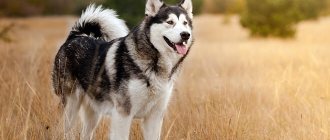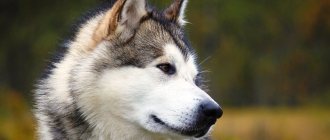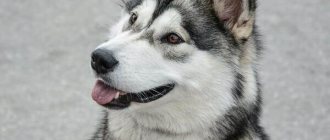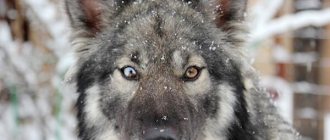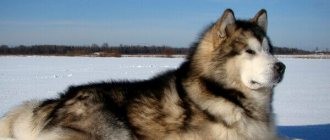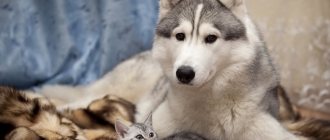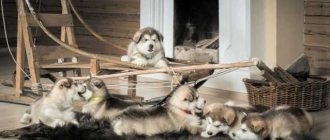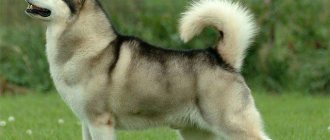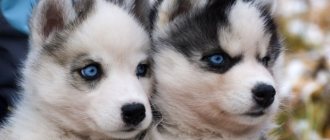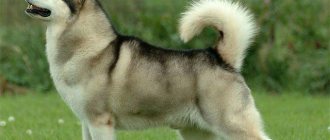The Alaskan Malamute is highly prized in the north. In northern latitudes it is used as a sled dog. An adult Alaskan Malamute dog is distinguished by sociability, endurance, large size, ability to work and a strong character, which is incredibly combined with friendliness.
Representatives of the oldest breed, walking with their owner, become the center of attention and arouse the admiration of others. They are often confused with cheerful and cheerful huskies. However, there is still a difference between the Alaskan Malamute and the Husky.
The main features of these wonderful dogs are strong limbs and great drafting ability. But it is their pretty appearance that makes Malamutes everyone’s favorite.
Description of the Alaskan Malamute breed
Popularity 190th place among 263 dog breeds
Lifespan:
14-16 years old
Breed group:
Service
Height:
males: 63 cm, females: 58 cm
Country of origin:
USA
Average price:
20-30 thousand rubles
Weight:
males: 36-43 kg, females: 32-38 kg
Latest articles Cat health
Rabies vaccination for cats: choice of vaccine, necessity, schedule 01/22/2022 15 0 0
Selection and adaptation
TOP 20 best cat breeds for families with children 01/22/2022 27 0 0
Price
The price of an Alaskan Malamute depends on its pedigree. An animal without one can be purchased for 10-12 thousand rubles. A puppy from purebred parents will cost over 25 thousand rubles. An animal born from dogs that have a number of titles and awards costs more than 35 thousand rubles.
Malamutes are very beautiful and gentle creatures, they love children and never conflict. But before you buy a dog, it is recommended that you once again read the information presented above. This will help avoid not only mistakes in parenting, but also disappointment.
Key facts
The description of the Alaskan Malamute breed emphasizes that it is a representative of a large breed of dog. The history of the origin of these northern giants is connected with the Malemute tribe, who previously lived on the coast of Alaska. From ancient times to this day, strongly built, muscular dogs easily cope with the work of dog sleds - all thanks to their physical endurance and resistance to harsh conditions. The external similarity of this beautiful dog with a wolf attracts increased attention.
The characteristics of the Alaskan Malamute breed say that the dogs are very smart and willful. The handsome Alaskan is good-natured, energetic and loyal, but by no means weak-willed or submissive. The stubborn nature of the Arctic giant and the desire to control his relatives and people sometimes prevent him from being raised under normal conditions. But when extraordinary situations arise, this character trait of the Alaskan Malamute can save a person.
The main feature of Malamutes remains their predisposition to draft work; without load, such dogs become lazy, spineless and stupid.
These giants are in good health, which is a great advantage of the breed. The lifespan of the Alaskan Malamute is long and easily reaches 15-16 years.
How to choose? Boy or girl?
to purchase a puppy from a specialized nursery - this eliminates the possibility of buying a purebred or sick pet .
It is also important to inspect the living conditions of the dogs, meet the puppy’s parents and find out about their health, since many malamute pathologies are hereditary.
The puppy should have shiny fur without bald patches or traces of dandruff, clean skin without rashes or irritations, pink mucous membranes, clear eyes without signs of increased lacrimation and other pathologies.
The puppy must be active, inquisitive, sociable, aggression is unacceptable.
When choosing between a male and a female, you should remember that girls are more docile and affectionate; some inconveniences in their maintenance are associated only with regular estrus.
Boys are more stubborn and willful, and tend to mark territory . At the same time, if you have plans to participate in breeding the breed, you should buy a female; if you plan to have an exhibition career, you should buy a male.
History of the origin of the Alaskan Malamute
The Alaskan Dog is the oldest representative of the indigenous dog breeds in North America. As archaeological excavations confirm, the Malamute is one of the first dogs domesticated by humans. Perhaps today's northern giants are descendants of once domesticated wolves.
When looking at these dogs, there really is a resemblance to wolves, which was proven by scientific research conducted in 2004.
The descendants of wolves came to Alaska thanks to their owners, who swam across the Bering Strait about 14 thousand years ago. The main purpose of the Alaskans was to transport heavy cargo in harsh Arctic conditions.
In ancient times, northern giants helped their nomadic owners hunt and also guarded their homes. Life in the far north played a huge role in the development of dogs as a breed. The constant lack of food, harsh living conditions, hopeless cold - all this contributed to the preservation of only those representatives who turned out to be stronger and more resilient than the rest.
At the end of the twentieth century, Alaskan Malamutes won the hearts of Europeans who came to Alaska under the influence of the gold rush. Streams of foreigners wanting to get rich from gold mining kept coming. And every European was interested in acquiring a convenient and reliable means of transportation on the ground.
Alaskans were the only animals that were able to withstand the harsh conditions of the north. They provided assistance in moving cargo and transporting people. The increased demand for these dogs contributed to an increase in their prices. By today's standards in dollars, then they paid for them from 13,000 for one unit and up to 40,000 for one team. Alaskans were in high demand among gold miners, despite the high price.
In an effort to obtain an even more hardy breed, Europeans tried to cross local Malamutes with Newfoundlands and St. Bernards brought specifically for this purpose. The breeders did not get the expected results, because the resulting offspring turned out to be unable to work as a team.
At the beginning of the last century, dog sled racing gained popularity in America. The sport gained historical fame in 1908 with a 408-mile race called the All Alaska Sweepstakes. Dogs from all over Alaska participated, and for the winning owners, this meant receiving monetary rewards and recognition.
But! Malamutes proved unsuitable for racing because they were not as fast as other competing dogs. Because of this, they tried to crossbreed Malamutes with representatives of small breeds. Attempts led to the threat of extinction of Alaskans as a species. In 1920, the number of these dogs reached a critical minimum. Only thanks to a team of enthusiastic breeders, consisting of several people, was it possible to preserve the breed.
The Second World War also caused great damage to the number of purebred dogs. The participation of four-legged helpers in hostilities almost led to the complete disappearance of the breed. In 1947, when there were only 30 Malamutes, through selection it was possible to restore the breed of Arctic beauties.
Today, Alaskans are considered a popular and famous dog breed. Many northerners will be happy to purchase such a pet. Adapted for centuries to hard work, dogs still perform their basic functions despite the fact that they have come to be considered the official symbol of the American state of Alaska.
Historical reference
Alaskan Malamutes are considered one of the oldest sled dogs; the exact date of origin of the breed is unknown. Most experts believe that it was bred by the Eskimo tribe, who were located in northern Alaska. Dogs were used to pull sleds and hunt. Malamutes began to be in great demand at the beginning of the 20th century during the “gold rush”. But such popularity had a negative impact on the breed - many gold seekers tried to get even more hardy animals by crossing Alaskan representatives with other dogs. The pure population was only expanded in 1926. The first standard was adopted in 1935 by the American Kennel Club, but recognition by the Fédération Cynologique Internationale occurred in 1963. Today the 1999 edition is considered valid.
Malamutes are used for harness work
Appearance of an Alaskan Malamute
General impression
The Alaskan Malamute is a powerful, hardy and friendly dog that looks very much like a wolf. This similarity causes not fear, but admiration. Even the photo of the Alaskan Malamute shows how beautiful and harmoniously built this dog is.
Head
Powerful, wide, deep-set. The head blends very harmoniously with the dog's body.
Neck
Strong, powerful, slightly curved.
Torso
Average, not very massive, but the bones are strong. Strong muscles are not visible under the thick fur - but rest assured, they are there.
Forelegs
The front legs of the Alaskan Malamute are quite well developed, they are distinguished by strong bones and powerful muscles. The paws are straight up to the pasterns, parallel to each other. The shoulder blades are slightly inclined. The pasterns are strong, but not long - deep, adapted for walking in the snow. The pads are well developed. The phalanges of the fingers are tightly pressed, curved. The claws are impressive.
Hind limbs
The hind limbs are no less powerful. Located on the same level as the front ones. The thighs are very muscular, the knees are medium angular. The hock joints are close to the ground, almost invisible. The toes and pads are the same as on the front feet.
Tail
Raised above the back, without touching it or twisting. Densely covered with fur.
Movements
Confident, smooth, but massive. Its impressive size does not prevent the Malamute from remaining agile. Strong hind limbs have the ability to transfer movement using the lower back to the forelimbs. The forelegs soften the powerful pushing force of the hind legs in a smooth and wide step. The front and hind legs move at a moderate distance from each other.
Wool
The Alaskan dog has a double coat.
The first layer of wool is hard to the touch, it performs a protective function. The second undercoat is soft but dense - it warms the animal. The length of hair varies on different parts of the body. For example, the neck, shoulders, rump, hips, tail and down the back have longer hair than the rest of the body. The Alaskan's coat becomes shorter and thinner in the summer, even if it is not clipped.
Color
Most of all, Malamutes are characterized by wolf coloration.
But they can also be black, gray, white. There is a sable color of the Alaskan Malamute. White hair is most often located on the lower part of the body, in rare places on the paws or as a mask on the face. There is a stripe on the forehead, a spot or a collar in the back of the neck.
Size
The Northern Beauty is a fairly large dog.
The weight of the Alaskan Malamute can reach up to 50 kg, and the height at the withers of some dogs is higher than 60 cm. On average, males of this breed weigh between 38-43 kg with a height of up to 63.5 cm, females – 34-38 kg with a height of up to 58 .5 cm. The height of the Alaskan Malamute is determined by the standard, but may exceed it if the individual is not a show animal.
The size of the Alaskan Malamute means that it will be kept in an aviary rather than in a cramped apartment.
Color variations
The color of the coat depends on which within-breed species the individual belongs to.
The coat of Alaskan Malamutes can be:
- black and white;
- gray-white;
- silvery white;
- red and white;
- sable
Representatives of the breed with a uniform coat color can only be white.
Character of the Alaskan Malamute
The Alaskan Malamute is a dog that perceives everyone around him with his inherent friendliness. These northern beauties are very energetic and active from early childhood - only by the age of three they become a little calmer. These dogs require increased attention: you need to constantly play and run with them.
Outwardly similar to a wolf, the Alaskan is not at all adapted to hunting or protection. So leaving it in the house in the hope that it will protect property from thieves is frivolous. Rather, he will kindly and joyfully greet the insidious burglar, mistaking him for a friend. Alaskans cannot bark, but they sing excellently.
Malamute strives to dominate everywhere. And if you raise him incorrectly, then he is unlikely to be good-natured and sociable. The pet has an excellent memory. This fact is important to consider when raising children. He can remember any rudeness committed during training later, and then even take revenge for it.
It’s difficult to call this pet a monogamous person: if you offend him and lose his respect, he can immediately switch his interests to another person. The Malamute is used to living in a pack, so it is important for him to be surrounded by people or dogs. At the same time, the northern giant cannot be kept in a confined space or left alone for a long time.
It is not advisable to leave a dog with small children, because in its desire to control everyone, it may inadvertently harm the child. Good-natured towards people and dogs, Malamutes often show aggression towards other animals and birds. In order for the handsome Alaskan to accept the company of other pets, he needs to be introduced to them as early as possible.
Most likely, the Alaskan will dominate among the other favorites. This Arctic dog has a strong character and a great desire to be above everyone else.
Education and training
Malamutes are very active and intelligent. From birth they are determined to lead. Therefore, when raising and training an Alaskan Malamute, it is important to be firm and confident. You need to let the dog know that it has an owner and he is the boss here, not the animal. But the pet will not tolerate aggression or attacks, so the best option is not to scold for mistakes, but to reward for correctly executed commands. It will be optimal to conduct training in a playful way.
The load during education should be increased gradually. You can train your puppy from a very early age. It is important to instill in him:
- hygiene skills;
- the habit of responding to a nickname;
- ability to execute simple commands.
You can go to training grounds from the age of 4 months, after the end of quarantine for vaccinations. If your pet lives in a big city, then you need to teach him to be calm about extraneous sounds, passing cars, and other sources of sudden noise.
Your pet will easily master long running distances, but only if it is not a test of speed - Malamutes are more resilient than fast. In these types of competitions, Alaskan beauties are inferior to other dog breeds, but if you need to drag a heavy load over long distances, then there is hardly a stronger opponent.
When training, the Malamute's stubbornness creates significant interference. But thanks to their exceptional mind and high intelligence, they can immediately remember and carry out any commands. Alaskans perform tasks no more than 2-3 times, because they do not like to repeat the same actions over and over again. Arctic dogs will quickly lose interest in the entire training process if this fact is not taken into account.
Looking for an Alaskan Malamute? Find your pet from 2 offers As a gift
Comparison with Husky
A very common statement is that the Alaskan Malamute and the Siberian Husky are similar in many ways.
People who are far from dog breeding often even confuse these breeds. I would like to note that there are still some common features in the appearance of these two breeds, but the differences are many times greater. You can immediately notice them if you put a photo of a malamute and a photo of a husky next to each other. Husky has shorter and softer hair, its eyes can be blue, brown, yellow, even multi-colored. In general, the Husky is more compact. A distinctive feature of huskies is their great mobility. They are very passionate, nimble, nimble, but at the same time less hardy than Malamutes.
If we compare the strength of these two breeds, it turns out that Malamutes will also take the palm here.
The only thing that is similar is the character of these dogs. Both breeds are quite headstrong, are considered poor watchdogs and require good exercise.
Health and Diseases of the Alaskan Malamute
Possible diseases
Alaskan Malamutes are very hardy.
They easily tolerate harsh climate conditions. But they are still susceptible to some diseases. They may exhibit neurological disorders affecting the peripheral nervous system – polyneuropathy. They are susceptible to diseases such as hip dysplasia, anal adenocarcinoma (malignant tumor), diabetes, and hemophilia. They are also prone to dermatological diseases such as atopic dermatitis and demodicosis. Less common eye diseases are: progressive retinal atrophy, cataracts, hemeralopia (day blindness), glaucoma.
To improve the health of an Alaskan, it is important to vaccinate him every year. Once a quarter it is necessary to do prophylaxis against worms, at least once every two weeks to clean the pet’s ears, brush the fur and teeth. In the warm season, you need to give a special anti-tick remedy.
Compared to other breeds, Alaskans are long-lived. Many of them live up to 16 years.
Reproductive health
Malamute bitches begin to come into heat around the age of one year.
If the first estrus was noted before 7 months of age, you need to contact a veterinarian, this may be bleeding. There is no need to rush into mating: a female can become pregnant normally only on her third estrus, that is, about 20 months. Males are bred no earlier than they reach two years of age.
Before going into heat, a dog can behave strangely: its character deteriorates, it becomes overly stubborn and restless. In addition, estrus occurs once every six months and lasts 20 days: in this case, the discharge from the loop is very abundant. This can be a problem for some owners, so unless you plan to breed, it is best to have your female Malamute spayed.
Mating
Malamute females begin puberty around the eighth month of life. One to two weeks before the first heat, the pet begins to exhibit strange behavior and urinate frequently, which is completely normal.
The first heat takes place in two stages:
- Mucous and bloody discharge appears (at this moment it will not be possible to breed - the female will not allow the male to come to her). This lasts for about ten days;
- Transparent discharge appears (mating can begin).
However, experienced breeders do not recommend breeding during the first heat, otherwise the offspring will be weak.
For the first mating, you can ask the breeder which cable is best to choose. The most important thing is that both Malamutes are healthy.
How is the knitting itself carried out? Usually mating is carried out in the morning (on an empty stomach).
There are two types of matings:
- Free – when they tie up already experienced parents who are not getting together for the first time;
- Manual – when the bitch is inexperienced and the couple needs help.
In the case of the second one, you need to act carefully. First, the dogs must get acquainted (this should take at least two hours). Then, to avoid injury, put a muzzle on the female and attach a cable. First you just need to put his paw on his back. This creates the illusion for the female that the cable has straddled her. And then mating already occurs. It can last from 15 to 40 minutes , and it is better to repeat it after 24-48 hours . If the mating was successful, you can expect a replenishment.
After this, you need to prepare for the appearance of puppies. To do this, it is better to allocate a separate room or barn and create all the necessary conditions for children there.
In the first month of pregnancy, you should not reduce the load; this will not harm the health of either the mother or the puppies. But in the second month it is better not to burden her with heavy exercises and switch to a lighter diet.
Approximately 10 hours before birth, pushing begins, and the pet begins to behave restlessly. At this moment, it is better to take her to the sun lounger and not leave her side. You shouldn’t forcefully hold her on the lounger; it’s better to just turn the attention to yourself with your affection. But as soon as labor begins, it’s better not to touch the mother. And after childbirth, you shouldn’t bother your family either. The mother must understand the new situation and begin feeding her children.
After some time, you need to call the female to you and wipe her genitals with a warm, clean rag. To do this, ask one of your relatives to take the Malamute for a walk and check for weak or underdeveloped puppies. They usually don’t leave them, because the chance that they will survive is negligible.
Over the next month, it is preferable to feed the female Malamute with broths, cereals, cottage cheese and kefir, and only then switch to food. It is necessary to ensure that there is always water in the bowl.
Features of feeding and diet
The Malamute is a rather large dog, but this does not mean that it needs to be fed a lot. On the contrary, it is necessary to develop clear feeding frameworks from puppyhood on a specific time and portion. Because a Malamute can eat any amount of food every time it is offered, even if it is full. Adult dogs should be fed no more than twice a day, while puppies should be given food three times a day at a strictly timed rate.
When choosing a diet, you need to take into account the norms, which for puppies are 140 Kcal per 1 kg of body weight, and for adult dogs - 75 Kcal/kg. For an elderly Malamute, it is better to stick to a diet that does not exceed 35 kcal per 1 kg of his body weight.
To feed puppies you can use: cottage cheese, boiled eggs (once a week), vegetables and fruits, raw or boiled meat, milk porridge, sea fish - boiled and boneless. Water should always be in an easily accessible place.
Adult Malamutes can be fed premium dry food. Such feed contains a sufficient amount of vitamins and microelements. In another case, a mixture of cereals is prepared for four-legged animals in broth with the addition of pieces of beef tripe or trimmings.
You can also feed your pets boiled meat, crackers and biscuits. It is advisable to do this infrequently and as a reward - for example, for a completed command.
Care and maintenance
The Alaskan Malamute has a thick coat, so it can live outdoors all year round. The main thing in the care and maintenance of the Alaskan Malamute is constant coat care. It needs to be brushed, especially when the dog sheds.
It is important for Alaskans to do a lot of physical activity, because it exercises not only the muscles of the body, but also the mind. Without exercise, Malamutes become lazy and disobedient animals.
A country house would be an ideal place to keep them, since the apartment is cramped and hot for giant malamutes. And in a house with a plot, the dog will feel much happier.
You should take into account the Malamute’s love of freedom and provide the pet with free movement from home to the yard and back. You also need to fence your territory with a high fence so that the Malamute does not run outside the fence. Provided that the dog lives outdoors, an excellent solution would be to make a spacious enclosure and place a warm booth there.
It should be remembered that Malamutes are excellent diggers! Even if your home is on a separate property, it is best to train your dog to dig only in a designated area, such as a sandbox in the backyard. Their ancient instinct, which once helped them find at least some food, has today degenerated into the process of obtaining pleasure. Many dog breeders can easily recognize the yard in which the Malamute lives by the pits dug in it.
Crossbreed
When these breeds are crossed, wonderful creatures are obtained: Haskomuts or Aluskys (Aluskys)
